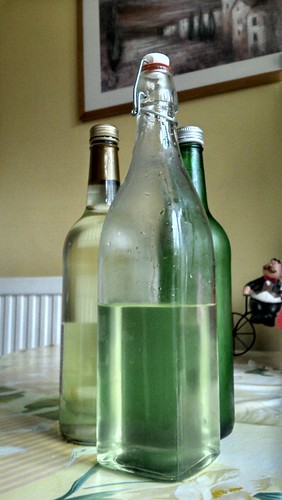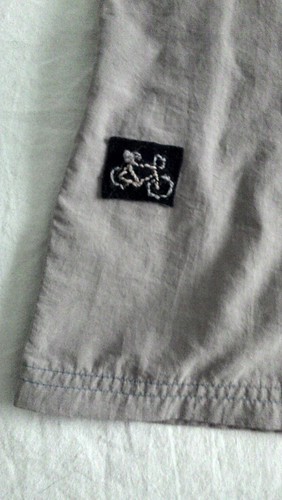I've been dabbling in fixing and rebuilding a lot; some might call it DIY, but its ad-hoc nature and reliance on existing materials make it feel more like a succession of real-life hacks. Nothing I can think of quite beats my raised bed built out of pallets (which has furnished us with a surprising amount of vegetables, given its small footprint in the garden) but there've been a few things I've made recently which I'm really pleased with.
Foraged food Living close to the countryside as we do, we have lots of opportunities for obtaining food for free. In previous years we've made kilogrammes of jam from wild blackberries; this year I tried my hand at making elderflower cordial. It was amazing.
With around 20 elderflower heads and two lemons (and 2kg of sugar), we made over two litres of cordial syrup. They're now in the fridge, awaiting Kate's birthday in August and other special occasions.
Making cordial involves enough extraneous purchases that it's only tangentially a permaculture hack: I would also need to work out more environmentally friendly ways of sourcing the sugar and lemons for it to qualify entirely.
Still - even if I do say so myself - the result beats anything shop-bought, hands down: present it as a gift or just keep it for your own personal stash. Especially if you're in the habit of buying cordials, this is a particularly enticing alternative.
Applying a patch I rarely buy proper cycling shorts: I look terrible in lycra, and the materials on non-lycra alternatives are often quite easily torn if they aren't purchased with enough give. Instead, I tend to wear light sports or swimming shorts. The only remaining disadvantage is that the material isn't easy to repair.
When one of my pairs of (practically) dedicated cycling shorts developed an odd tear in the middle of one of its fabric panels, it looked destined for the bin. However, I remembered when I was a kid that my Mum bought a bundle of patches, with miscellaneous and typically meaningless designs on them, for repairing casual clothes where darning or sewing a seam wouldn't suffice.
It seems a lot of hassle to buy patches like that any more - high-street shops have very few opportunities for repair in them, when replacing them with new goods simultaneously inflates the market for such goods - so instead I made one. I sewed a rather wonky design of a bike on a piece of leftover felt, trimmed it, and glued it in place. After the glue had dried, I sewed the edge of the patch in place: doing both is apparently recommended.
So: more mending and less buying new than elderflower cordial; although the felt was technically new material. Can we increase the fraction of reused components any more?
Candle from candles We go through phases of liking, and lighting, candles and tealights. Especially at this time of the year, when you want to prolong darkening evenings sat in the garden, a bit of extra illumination is always welcome.
Tealights especially always seem wasteful to me. Apart from their metal cases (unrecyclable, as far as I can tell) they always have a substantial residue of wax inside them. We had kept a few of them for some time, unhappy throwing good lighting away, but uncertain of how to achieve it.
Here you see pictured a candle of candles, in a reused candle glass. Dozens of tealights, plus a few fragments of a bigger candle that was burning unevenly, were melted in the glass by warming it up along with a panful of water. The two wicks are weighted down with an old metal bolt, and are made of the string which routinely ties up the vegetable box we get delivered.
It burns tremendously well; the two wicks are a godsend, as any one on its own would burn too fast compared to the surrounding wax and the candle would go out. I've been suspicious in the past of making your own candles, soap etc: unless you're really set up to do it, it can turn out to be far more resource intensive than before. But notwithstanding a bit of gas to briefly heat up the pan of water - which also went on the garden at the end of the project - this project felt very much like generating a new, useful object out of discarded remains, themselves usually deemed useless.
... Anyway, those are three of my recent "not quite crafting" projects. For me to be able to hack something together from materials I have to hand, especially when the project either extends the life of an existing purchase, or prevents me from buying a new item altogether: those capabilities are important if I want to have an enriching, eventful life that leaves its traces in everything except diminishing resources and damage to the environment. There exists an axis of permaculture on which one can craft and hack and live; and, more importantly, live well.
Next time I think of representing someone having an idea with an ecological alternative to the halogen light bulb, I won't think of a low-energy equivalent: I'll imagine a candle, made of candles, burning brightly over their head!



